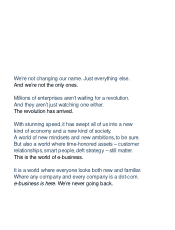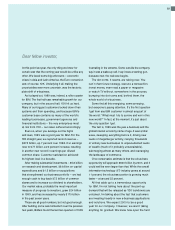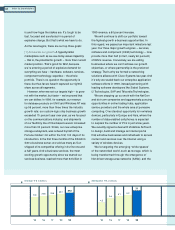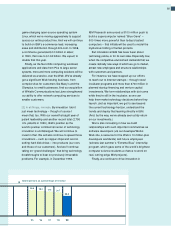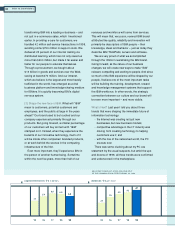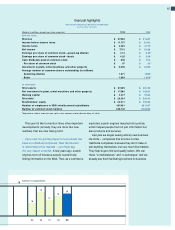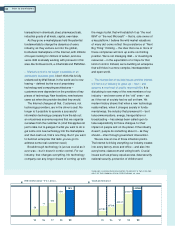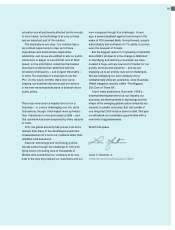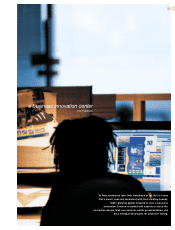IBM 1999 Annual Report Download - page 5
Download and view the complete annual report
Please find page 5 of the 1999 IBM annual report below. You can navigate through the pages in the report by either clicking on the pages listed below, or by using the keyword search tool below to find specific information within the annual report.
At this point last year, the only thing we knew for
certain was that the coming year would be unlike any
other. We faced some big unknowns – economic
crises in Asia and Latin America, the Euro conversion
and, of course, Y2K. Underlying it all, making the
uncertainties even more uncertain, was the tectonic
plate shift of e-business.
As it played out, 1999 was, indeed, a roller coaster
for IBM. The first half saw remarkable growth for our
company, but in the second half, Y2K hit us hard.
Many of our biggest customers locked down their
systems and their spending, and because IBM’s
customer base contains so many of the world’s
leading businesses, government agencies and
financial institutions – the very enterprises most
at risk from Y2K – our sales suffered accordingly.
Even so, when you average out the highs
and lows, 1999 was a good year for IBM. For the
fifth straight year, we reported record revenue –
$87.5 billion, up 7percent over 1998. Our earnings
rose to $7.7 billion, a 22-percent increase, resulting
in another new record in earnings per diluted
common share. Customer satisfaction achieved
its highest level in a decade.
After making substantial investments – $5.8 billion
on research and development, $6billion on capital
expenditures and $1.5 billion on acquisitions
that strengthened our business portfolio – we had
enough cash to buy back $7. 3 billion of common
shares and to increase our dividend to shareholders.
Our market value, probably the most important
measure of progress to investors, grew $24 billion
in 1999, and has increased by nearly $170 billion
in the past seven years.
Those are all good numbers, but not good enough.
After building some real momentum over the previous
two years, IBMers found the last two quarters of 1999
frustrating in the extreme. Some outside the company
say it was a wake-up call. I say it was a starting gun,
because now, the real race begins.
The dot-coms, it seems, are taking over. You
can’t chart future strategy, execute a transaction,
invest money, even read a paper or magazine
or watch TV without, somewhere in the process,
bumping into dot-coms and, behind them, the
whole world of e-business.
Some find all this energizing, some annoying,
but everyone’s paying attention. It’s the first question
I get from any IBM customer in almost any part of
the world: “What must I do to survive and win in this
new world?” In fact, at the moment, it’s just about
the only question I get.
The fact is, 1999 was the year e-business and the
global Internet economy came of age. It was a tidal
wave, sweeping everything before it, driving new
levels of megamerger activity, carrying thousands
of entirely new businesses to unprecedented levels
of wealth (much of it probably unsustainable),
submerging almost as many others, and rearranging
the landscape of commerce.
One conservative estimate is that the e-business
opportunity will approach $600 billion by 2003, and it
could well be even larger than that. While the overall
information technology (I/T) industry grows at around
11 percent, the e-business portion is growing much
faster – at around 22 percent.
All that adds up to a tremendous opportunity
for IBM. I’m not talking here about the pent-up
demand that will be released as Y2K lockdowns are
unlocked. I’m talking about the fact that customers
are investing heavily in new e-business applications
and solutions. We expect 2000 to be a good
year for our company. However, we aren’t taking
anything for granted. We know how open the field
Dear fellow investor,
03



